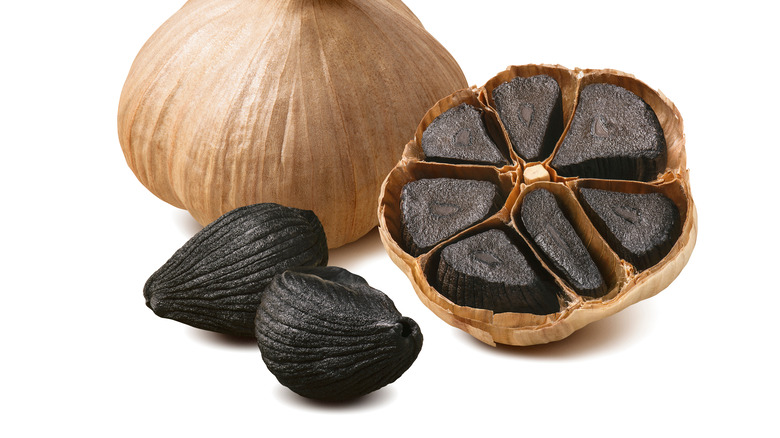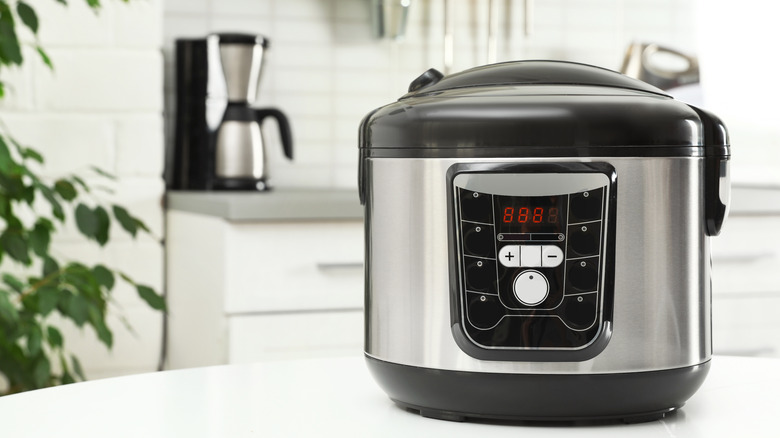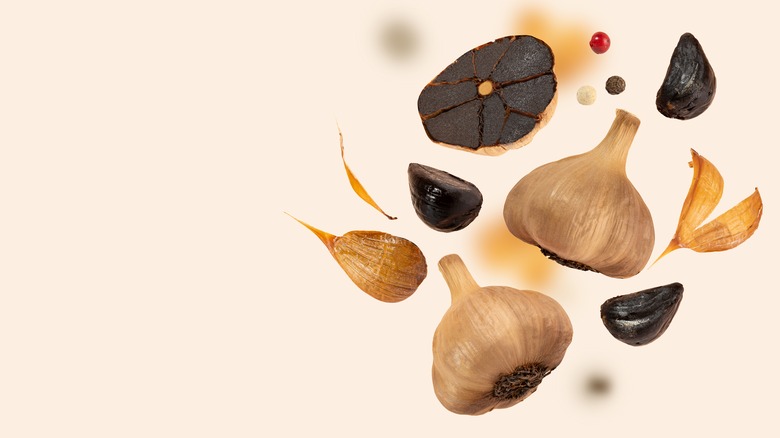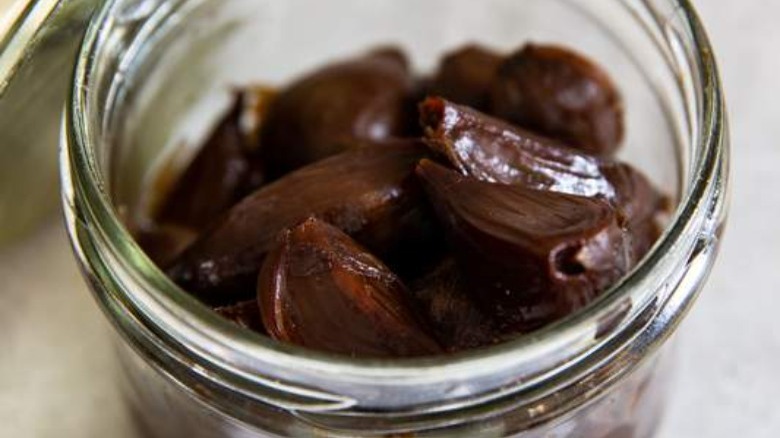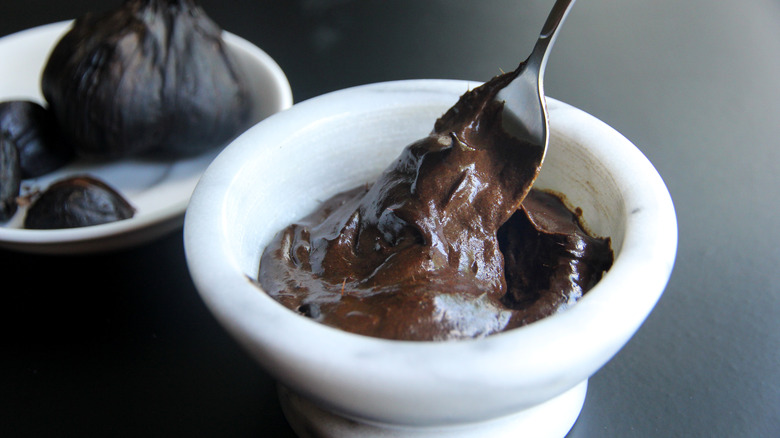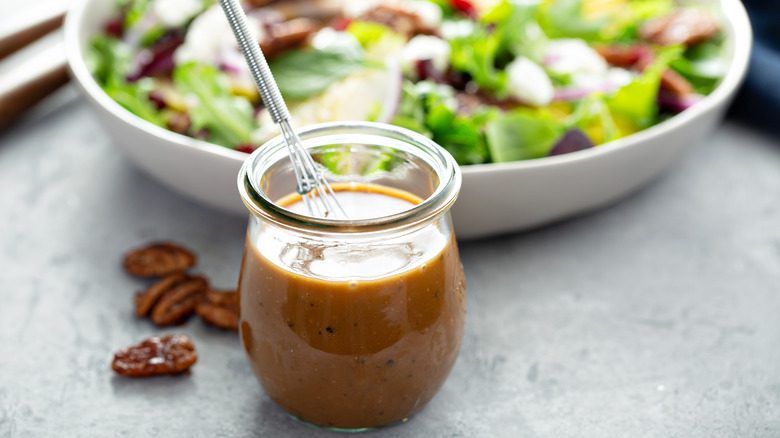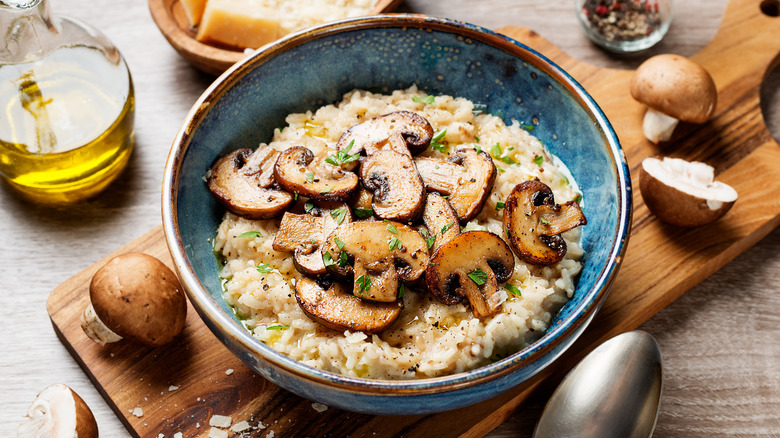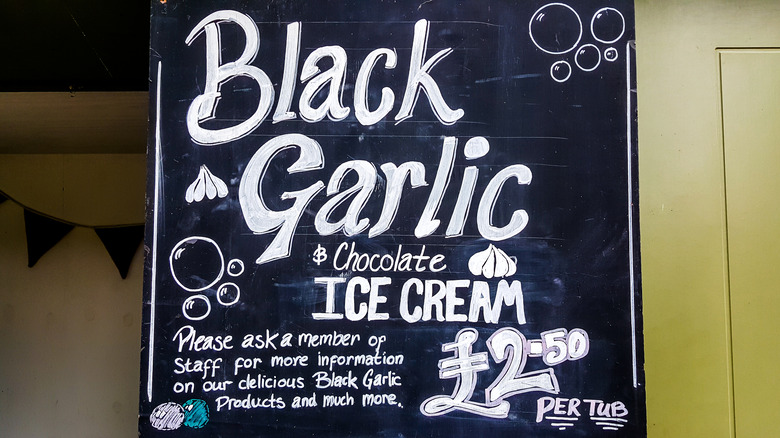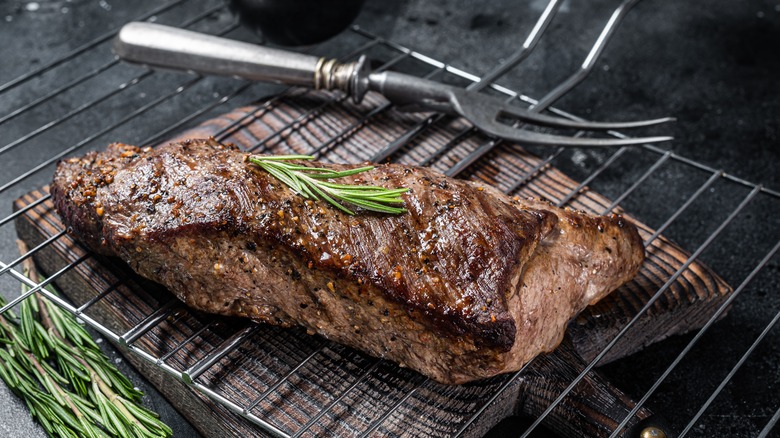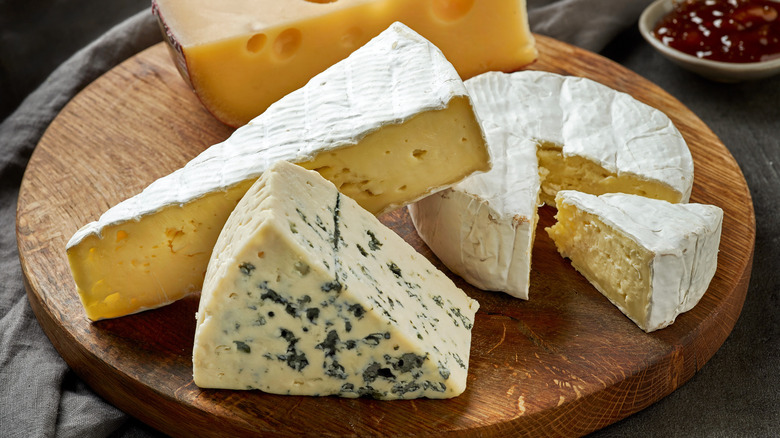9 Tips You Need When Cooking With Black Garlic
We may receive a commission on purchases made from links.
Even though the Netflix series "Stranger Things" isn't based on true events, eating black garlic will have you wondering because it is like taking a trip into the Upside Down. It resembles fresh garlic, but black garlic is darker, squishier, and more mysterious — a departure from everyday life.
So, what is black garlic? Not a variety of garlic, it's made from fresh garlic that has been cooked very low and very slow: at 140 F over the course of many weeks. This "blackening" process is similar to caramelization, which occurs when sugars are cooked much faster with higher levels of heat (via Science of Cooking). Blackening often gets confused with fermentation. However, they are not one and the same because the bacteria needed for fermentation cannot survive at 140 F (via Illinois Times).
Weeks of low and slow cooking have profound and positive effects on garlic. The white skins of fresh garlic become a caramel color, and the cloves themselves turn black. Garlic flavors fade into the background, and a rich, complex sweetness emerges. People who have tasted black garlic often say it evokes flavors of molasses, anise, balsamic vinegar, and chocolate (via Black Garlic).
You can make black garlic at home, albeit with a significant time investment. You can also buy black garlic at a premium price. Given the time and financial costs, it's important to use this ingredient properly. Consider these tips when making and cooking with black garlic.
You can use a slow cooker to make black garlic
You only need three things to make black garlic: fresh garlic, a slow cooker or a rice cooker with a precise temperature setting and time. Start by gathering enough garlic bulbs to fill your device while allowing space in between. Remove the outer layer of skin to eliminate dirt and cut off roots. Wrap each bulb in foil so moisture cannot escape. Place bulbs in the cooking device, set the temperature to 140 F, and secure the cooker's lid. The only thing left is to wait and periodically check on your bulbs.
Be aware that the garlic smell can become very overwhelming (especially during the first week), and it may be best to place the cooker in the basement or garage. According to The Noma Guide to Fermentation, you should check your bulbs after the first week to see how they're progressing. The skin should start to tan and appear damp. If any of your bulbs appear burned on the bottom or seem dried out, they won't blacken properly and should be removed.
Your garlic should be left in the cooker for at least three weeks. However, according to the Noma guide, full flavor development does not occur for six to eight weeks. Your bulbs will be ready when the cloves are black and shrunken to the point that they have pulled away from the skins. When the bulbs appear ready, they should be removed from the cooker, unwrapped, and allowed to dry out on a dry surface for one day before storing them in a refrigerator or freezer.
Never mince black garlic before cooking
Fresh garlic is a pungent ingredient, and most recipes call for it to be minced before it's added to a dish. Mincing produces a flavor compound called allicin, and cooking under low heat degrades this compound, according to the National Therapy Institute. This process helps to disperse the strong garlic flavor within the larger dish, preventing it from overpowering the other ingredients.
The appeal of black garlic is rooted in subtle, complex flavors, and this is why you should never mince black garlic before cooking it. If you do, you will decimate what little fresh garlic flavor remains, completely offsetting the complexity of this ingredient.
Mincing black garlic is perfectly acceptable, however, if you don't intend to cook it. For example, if you're looking to make black garlic aioli or black garlic vinaigrette, mincing helps disperse the black garlic flavor. Just make sure you don't use the aioli or vinaigrette for cooking.
Make black garlic confit
Confit is a cooking technique that involves slowly cooking something in fat. This may sound similar to deep frying, but confit cooking involves much lower temperatures, about 200 F. The technique is often used to make pork, chicken, or duck incredibly succulent, but it can also be used as a method of preservation. When a perishable food item is stored in fat, it deprives many types of bacteria and different pathogens of the oxygen they need to proliferate (via Food52).
In addition to being easier to store, confit garlic cloves are more convenient to cook with, as they readily spread and melt into dishes. While you can buy black garlic confit from specialty shops like East Jerusalem Good Company, it's a great way to get the most out of homemade black garlic and pretty easy to do. All you need to do is cook black garlic cloves in a neutral oil at a low temperature for around 45 minutes.
One potentially fatal mistake to avoid when making garlic confit is not refrigerating it. The Clostridium botulinum bacteria that cause the deadly neurological disease botulism can survive in a low-oxygen environment (via CDC). Keeping black garlic confit refrigerated and eating it within a few weeks are the recommended ways to avoid getting botulism from preserved foods.
Upgrade aiolis and creamy dressings
With black garlic's notes of molasses, anise, chocolate, and — well, garlic — it should come as no surprise that this ingredient works well in creamy preparations, especially aiolis and dressings.
One of the most common uses is in black garlic aioli. If you're feeling lazy, you can just combine store-bought mayonnaise and black garlic in a food processor. When you're a bit more ambitious, you can use a traditional garlic aioli recipe, which requires eggs, lemon, garlic, olive oil, and a food processor or blender setup that allows you to stream in the oil while it's running. One of the best uses of black garlic aioli is as a sandwich spread.
Another great way to use black garlic is ranch dressing (via Rachel Ray Show). Switching from regular garlic to black garlic infuses ranch dressing with more complex flavors. It's also a great alternative for those rare people who don't like too much garlic flavor in their food.
Use black garlic in a vinaigrette
While some uses of black garlic look to harmonize with the ingredient's molasses-like sweetness, using it in a vinaigrette takes a more contrarian approach, pairing sweetness with sour. Black garlic pairs exceptionally well with balsamic vinegar. In fact, Whole Foods sells premade black garlic balsamic vinaigrette.
The typical homemade vinaigrette salad dressing recipe is a pretty straightforward affair. In a three-parts-to-one ratio, add oil and vinegar to a mason jar. Next, add salt, pepper, minced black garlic, and other seasonings. Place a lid on the jar, screw it tight and shake vigorously to create an emulsion.
In addition to being great on a salad, vinaigrettes are commonly used as a finishing sauce for red meat. To make this type of vinaigrette, add one head of black garlic, one teaspoon Dijon mustard, one teaspoon honey, 1/2 cup balsamic vinegar, and a pinch of salt into a bowl and puree until smooth. Then, slowly drizzle 1/2 cup olive oil into the bowl while continuously whisking (via Marx Foods Recipes).
Make a more flavorful risotto
A well-made classic risotto is flavorful on its own, but the inclusion of black garlic in risotto is a natural one that elevates the dish to new heights. A key ingredient of many creamy risotto recipes is sautéed onions, and the addition of garlic adds a bit of earthiness and mild anise flavor.
After you have sautéed onions and toasted your rice, toss in a couple of black garlic cloves just before adding your wine and chicken stock. As you incrementally add stock, be sure each ladle is completely absorbed before adding the next one, stirring the entire time. The rice in your final dish should be al dente.
Risotto is also a great dish for expressing yourself with various mix-ins. If you use black garlic, consider what additions will make the most of this premium ingredient. According to Umami, mushrooms are a natural pairing with black garlic as they playoff its earthy sweetness. Toasted pine nuts add a great texture that doesn't get in the way of black garlic's subtle flavors as well.
Play off of black garlic's sweetness
Black garlic can be quite sweet, and this quality allows it to pair well with other sugary ingredients like maple syrup and honey. Many professional chefs take advantage of black garlic's sweetness by incorporating it in cookies, pies, and even ice cream.
For the most part, including black garlic in a chocolate chip cookie recipe takes advantage of its sweetness, but the garlic flavor in the background adds a savory element that translates into a welcome complexity. The amount of black garlic you add will depend on your taste, according to an otherwise standard cookie recipe from Black Garlic North America.
Making black garlic ice cream may sound like a stunt or novelty, but a number of chefs have proudly featured it on their menus. Some versions of black garlic ice cream are more savory than sweet, and one chef in New Orleans has featured it with wagyu tartar (via NOLA.com). The government of the Philippines sees such promise in black garlic ice cream that it has actually conducted marketing tests of it as a way to promote garlic production on the island nation (via DOST-PCAARRD).
Give steaks an aged quality
It is pretty impractical for the average person to dry-age their own steaks. While it doesn't replicate the flavor of a true dry-aged steak, using black garlic in a steak rub adds significant depth of flavor and requires a lot less time (via Over the Fire Cooking). If you are grilling steaks, rubbing both sides with black garlic — or using black garlic butter — results in a better char, as the sugars from the garlic will caramelize in high heat. A black garlic rub also works well on pork and venison.
However, black garlic probably pairs best with beef, and not just when it comes to steaks. According to Great British Chefs, about five cloves of black garlic in a standard recipe of Bolognese sauce or chili con carne can cut through the heartiness of these dishes, allowing the garlic's unique flavor to shine through. One additional key Bolognese ingredient that you'll never want to skip is warm milk. Not only is the inclusion of milk traditional, but it also pairs well with the molasses and chocolate notes of black garlic.
Pair black garlic with cheeses
As noted by Good Housekeeping, anyone who has had onion chutney on their cheese board knows the sweet and savory condiment can have a transformative effect. With its subtle notes of dried fruit, black garlic is an excellent substitute for a cheese board's sweet onion chutney (via Great British Chefs). The added complexity of black garlic pairs particularly well with creamy blue cheese or salty feta.
Obviously, a cheese board isn't just about black garlic. If you're looking to create the ideal cheese board, go to a specialty cheese shop and purchase a balanced assortment that includes at least one creamy cheese, semi-firm cheese, hard cheese, and blue cheese. A perfect cheese board also has cheese made from different kinds of milk, including cow, goat, and sheep.
The accompaniments for your cheese board should also go beyond black garlic. Honey, nuts, dried fruit, fresh fruit, crackers, and bread should all be represented. If you are so inclined, you should also consider pairing wine and cheese.
